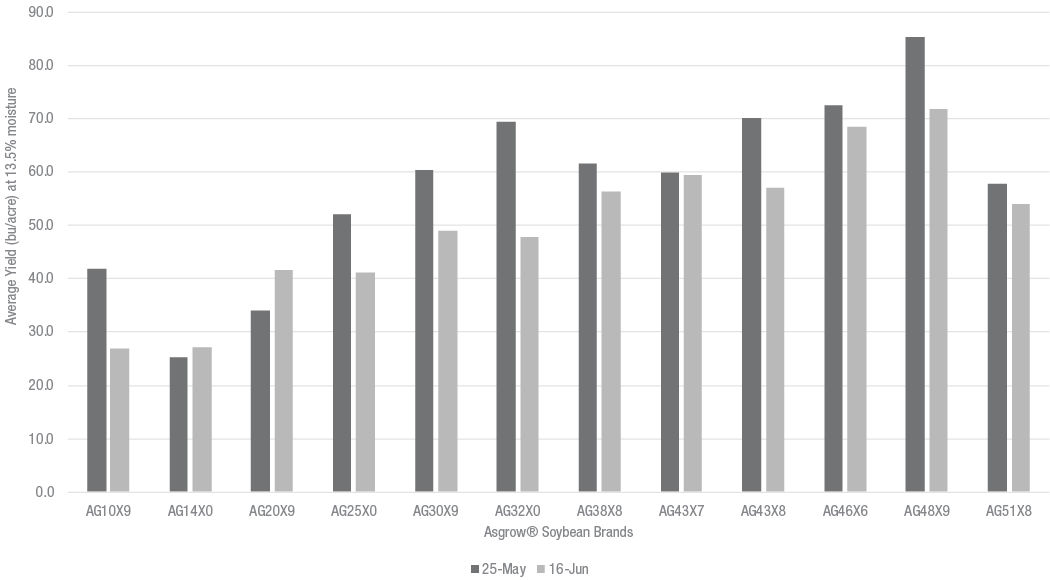Soybean Planted on Different Dates and Harvested on the Same Date
January 26, 2021
TRIAL OBJECTIVE
- The Bayer Learning Center at Scott, Mississippi has several years of data regarding planting soybeans from widely different maturity groups on various dates ranging from early to late for our latitude.
- Many growers in the Midsouth face a dilemma in planting fields affected by flood waters. Sections of the field will typically dry earlier than others as flood waters recede. Late-planted soybeans often face major challenges from late season weather patterns (hurricanes, rainfall, and frost) as well as late season insect and disease pressure as compared to earlier planting dates. Therefore, to minimize the risk, as much of the field should be planted as early as possible.
- Questions often arise about harvest difficulties in this scenario.
- Can an earlier maturity group be planted later (after waters recede) and minimize harvest difficulties associated with different planting dates?
- Or stated another way, can two different maturity groups be planted on different dates and harvest at the same time?
- A single harvest date could minimize concerns with several issues including:
- Multiple harvest desiccation/harvest events per field.
- Maintaining productivity even if yields are somewhat lower by reducing production costs (insects), risk (disease, weather and harvest costs).
- What is the yield potential in this type of system?
- Can an earlier maturity group be planted later (after waters recede) and minimize harvest difficulties associated with different planting dates?
RESEARCH SITE DETAILS
| Location | Scott, MS |
| Soil Type | Mixed silt loam |
| Previous Crop |
Corn |
| Tillage Type |
Conventional |
| Planting Date | 05/25/20, 6/16/20 |
| Harvest Date | 9/8/20 through 10/23/20 |
| Potential Yield (bu/acre) |
85 |
| Seeding Rate (seeds/acre) |
120,000 |
- All agronomic practices were per local standards.
- 14 days prior to listed harvest dates appropriate desiccants were applied to facilitate harvest.
- All yield data was collected using commercial equipment recorded using Precision Planting® YieldSense™ yield monitoring systems and corrected to 13.5% moisture for reporting.
- Single replicate strip plot design with plot size of approximately 1 acre.
- Planting dates
- Single soybean product treatments
- May 25, 2020
- June 16, 2020
- Prepped and harvested as agronomically appropriate50/50 treatments included 2 different soybean products planted on different dates (Figure 1).
- 50% on May 25 planted to later maturity groups.
- 50% on June 16 planted to earlier maturity groups.
- Prepared for harvest and harvested on dates close the single soybean product treatments.
- Single soybean product treatments

UNDERSTANDING THE RESULTS

Even though early planting was delayed by weather events during 2020, generally speaking, the earlier planting dates were yielded higher in most soybean products, which is typical for the Bayer Learning Center at Scott, Mississippi (Figure 2).
Mid to late maturity group (MG) 4 soybean products yielded best in this study (Figure 2).

For this trial, early planting of the regionally-adapted (normal) soybean products appeared to have the highest yield potential.
When considering an early planting of a normal soybean product followed by later planting of early soybean products, growers should consider the possible risks/gains.
In this case, the timely planted/normal soybean product followed by the later planted/early soybean product showed potential, but not without a yield penalty.
In two of the three cases presented here the timely/normal soybean planting had a higher yield than the late/early soybean planting by an average of 18.4 bu/acre or an average loss of $220/acre at a $12.00/bu market price. The potential benefit of the mixed planting would be harvest timing that could avoid the expense and trouble of moving harvest equipment to the field multiple times for harvest, but this benefit may come at a relatively high yield cost.
In some cases, the later planted, later maturing soybean products suffered an 8.9 bu/acre yield loss or $107/acre loss. A disadvantage could be additional insect control and weather-related risks associated with a longer growing season.
Growers should carefully evaluate these various scenarios (including how much of the field should be planted early versus late, this was a 50% mixture) and the associated decision points before selecting mixed plantings of soybean to manage harvest timing.
This study shows there does appear to be potential to choose earlier MG soybean products for a late planting of partial fields behind flood waters. Some yield reduction was observed but that would be offset by savings in late season inputs, increased yields from early planting of partial fields, and decreased harvest costs (Figure 3).
KEY LEARNINGS
Growers should take many parameters (soil type, disease pressure, crop rotation, etc.) into consideration when making decision about soybean products, planting dates and harvest timing.
Growers should consult with their local Bayer seed representative for more information.
3011_R20_20